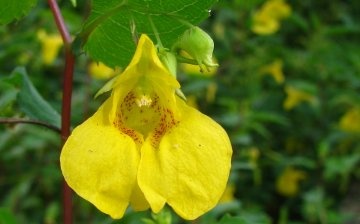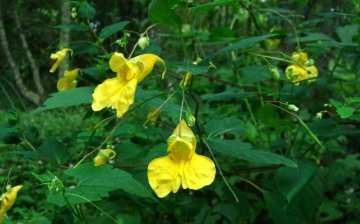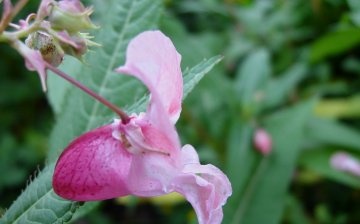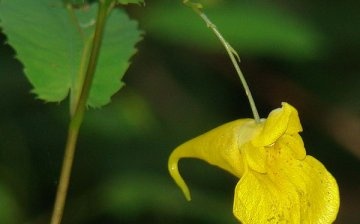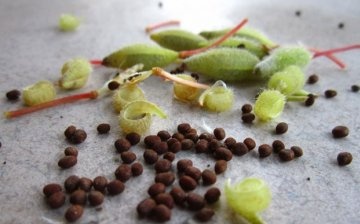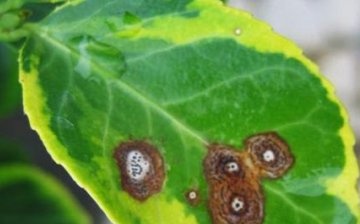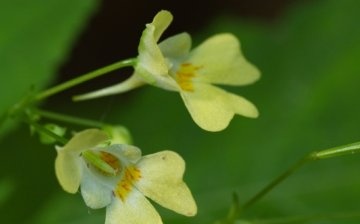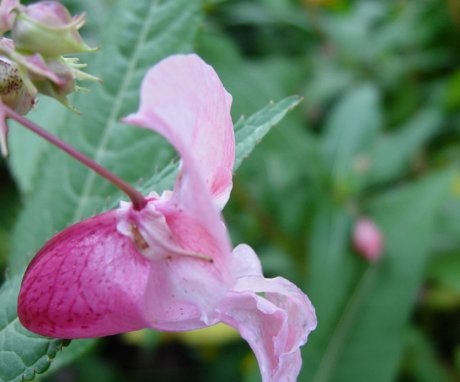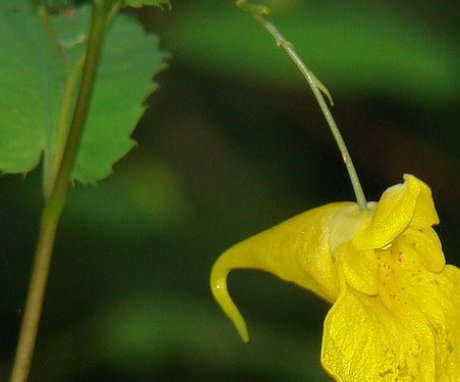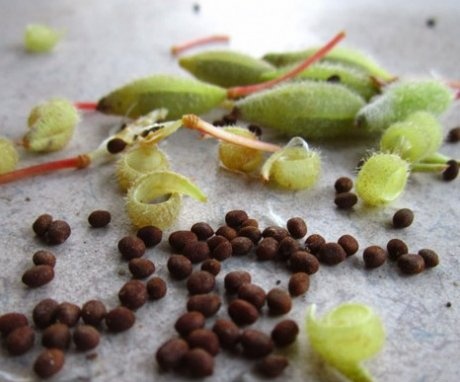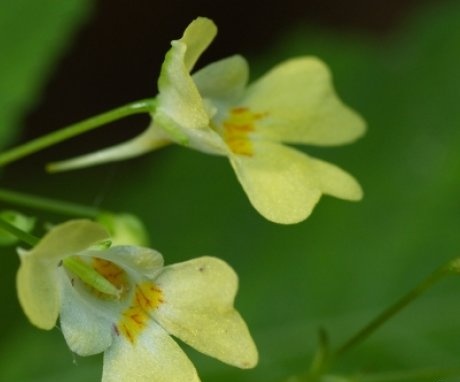Touch-me-not plant: varieties, features of care and reproduction
Among the many species and varieties of ornamental flowering plants, there are often those that are suitable for indoor growing and for planting in gardens. One of these plants is touchy or balsam. People call it "light" because of the red color of the flowers of one of the varieties.
Content:
- General information about the plant
- Impatient varieties
- Correct care
- Breeding secrets
- Diseases and pests
- Plant application
General information about the plant
Impatiens are perennial a herb that belongs to the Balsamin family. Annual varieties are grown outdoors. The native land of the plant is the tropical and subtropical territories of Africa and Asia.
The bushes grow up to 100 cm in height, the dwarf varieties do not exceed 25 cm. The stems are thick, knobby, fleshy and rich in juice. Leaves are oblong oval, lacent, jagged at the edges, their color depends on the touch-me-not variety.
Flowers also change depending on the type of plant, they are single or collected in inflorescences, with simple or double petals, large or small.
After flowering fruits are formed in the form of a drop-shaped elongated five-leafed capsule. When opened, each flap is twisted, there are seeds in the middle. The touch-sensitive grows very quickly, and flowering lasts from late spring to mid-autumn. In home indoor conditions, the buds form and open almost all year round.
Impatient varieties
Popular plant varieties:
- Touch-me-not golden. Large perennial bush, the height of which can reach 100 cm. The stems are highly branching, the leaves are oval, carved, green in color. The flowers are in the shape of "shoes" and are colored yellow.
- Impatiens small-colored. An annual shrub, the height of which can reach 60 cm. The stems are erect, strongly branching. Leaves are medium in size, ovoid, oblong, serrate at the edges. The flowers are small, collected in loose inflorescences.
Correct care
A touchy unpretentious plant, it is often found both in summer cottages and urban flower beds, and on the windowsills. Care behind it, a simple and timely update will keep the flower in a beautiful and blooming form.
- Touch-me-not grows well in sunny areas and in partial shade. The place for landing, nevertheless, it is advisable to pick up sunny, with fertile loose soil. Indoor varieties are recommended to be grown on the east and south windows. In the shade, the branches of the plant will begin to stretch and the flower loses its decorative appearance and density of the bush, and the number of flowers also decreases.
- The plant does not tolerate dry weather and needs regular watering. But waterlogging of the soil leads to rotting of the roots and the death of the entire plant. therefore watering carried out regularly, each time checking the soil for moisture. This applies to both indoor varieties and those grown in gardens and open areas.
- Dry air has a detrimental effect on the touch-sensitive; when watering, it is recommended to moisten the leaves with a spray bottle. With constant dry air, a spider mite may appear on the branches.
- After watering, the soil is loosened and removed weeds... This process will allow excess water to escape and the roots to allow additional air to pass through. Weeds also create thickening, which can lead to rotting of the lower branches and roots.
- In open ground hard-to-reach is planted only when the weather becomes stably warm, and the soil warms up well. Typically, this period falls at the beginning of June. The soil can be composted, dug up and watered.
- Pits for seedlings dug out at a distance of 30 cm from each other, so that the plant has room for development. Temperatures below +5 degrees have a detrimental effect on the plant, its growth slows down and with a prolonged cold snap the bush dies.
- Top dressing carried out regularly during the growing season. For this, a weakly concentrated fertilizer complex purpose. It should not contain nitrogen, which will increase the number of leaves and reduce the volume flowering.
- To preserve decorativeness and stimulate the growth of new buds, it is recommended to remove wilted flowers. IN pruning the plant does not need, as it independently forms bush.
- Indoor varieties need to be updated every 2-3 years. In this case, the mother bush is thrown away, and the cut from it cuttings rooted and planted in its place.
Breeding secrets
You can propagate touchy with the help seed and cuttings... For seed propagation, you can use purchased seeds or collected from bushes. Freshly harvested have excellent germination, which they retain for 5-8 years.
For sowing, it is necessary to prepare a container with a fertile, loose substrate with the presence of river sand.
To prepare seedlings for planting in open ground, sowing is carried out in late February or early March. For indoor plants, this operation can be carried out all year round. The seeds are carefully laid out on the substrate and sprinkled on top with a small layer of wet sand. A greenhouse is erected above the crops or the entire container is transferred to a greenhouse, where the ambient temperature is in the range of 25-26 degrees.
Shoots should appear in 1-1.5 weeks. When 2-3 adult leaves appear on the sprouts, they can dive in separate pots. In these containers, touch-me-nots will grow until they are planted in open ground. They need regular watering and humidified air.
When planting, it is recommended to cut the main root by a third to stimulate root growth.
Almost all varieties of touch-me-nots reproduce by cuttings. The process is carried out during the growing season. The tops of the stems are cut off so that 3-4 healthy nodes are preserved. Rooting is carried out in wet sand and under a greenhouse. After a week, the first roots should appear, after another week the plant can be transferred to a peat substrate in a separate pot.
Diseases and pests
Impatient pests:
- The touch-me-not is susceptible to the attack of a spider mite. This occurs mainly during the heating season, when the air is very dry. Of this pest can be seen by the appearance of bronze spots on the leaves.
- Also, the plant is susceptible to attack by whiteflies and aphids. To get rid of these insects, you can use special products that can be purchased at a flower shop.
Diseases in touch-me-not appear only due to improper care. For example, wilting of leaves indicates that the plant is not getting enough nutrition and moisture, and foliage begins to fall off when the temperature drops sharply.
Weak flowering and elongation of stems begins with a lack of lighting, an excess of nutrition at a constant high temperature.
It is recommended to expose the flower to a more illuminated place, and with a strong increase in the growth of stems, root the petioles, and discard the mother bush. Root decay can begin with constant waterlogging of the soil. At the same time, the plant begins to wilt.To save him, you need to take out all the roots, dry a little, remove rot and plant in a new substrate.
If after transplanting for a long time the bush does not bloom, then the pot is large. Touch-me-not loves crampedness, so you have to either wait for the bush to grow and begin to bloom, or transfer it into a smaller container.
Plant application
Touch-me-not is used for decorative purposes. It is unpretentious, therefore it is suitable for decorating city parks, streets and alleys. It can often be found in compositional drawings on flower beds during various holidays. It is also a common houseplant.
Cultivation of touch-me-nots is quite simple and rewarding. With proper care, you can get a thick, beautiful and long-lasting bloom.
More information about growing flowers in the garden can be found in the video.



